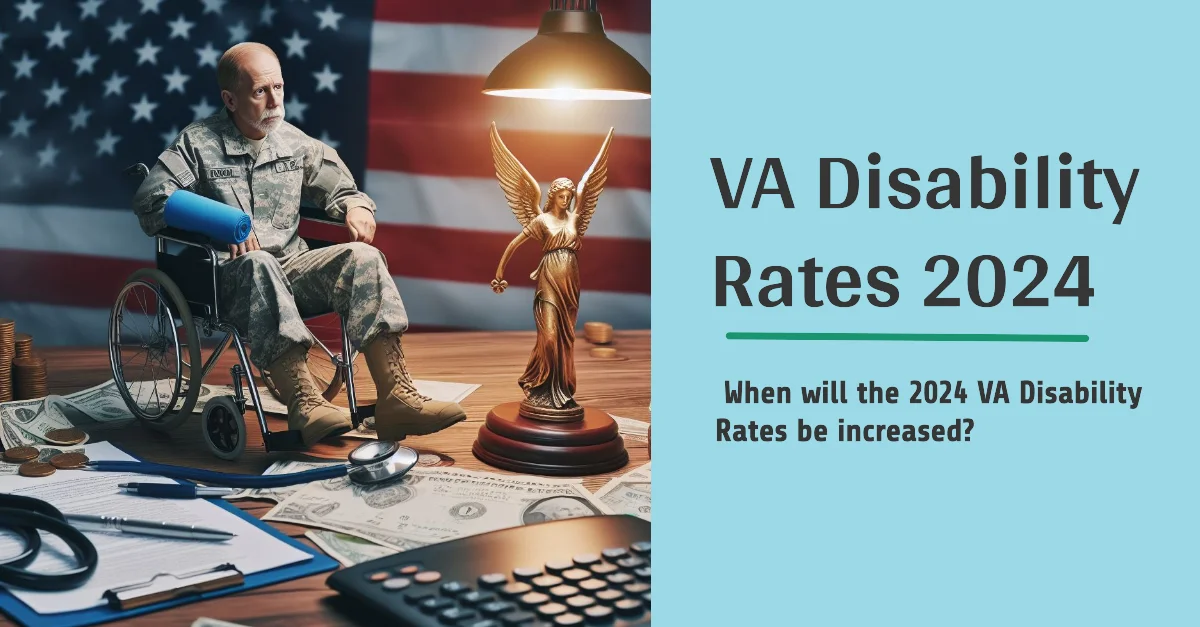For Advertising Contact Us
VA Disability Rates 2024 – When will the 2024 VA Disability Rates be increased?

Rates for VA disability benefits are crucial for veterans who rely on this financial support. In 2024, veterans can expect increases in their disability rates to keep up with the rising cost of living. Understanding when these increases will occur is important for veterans to plan their finances accordingly. Let’s explore into the details of when the 2024 VA disability rates will be increased and how it could impact veterans.
Types of VA Disability Compensation
To effectively understand VA disability rates, it’s crucial to grasp the various types of VA disability compensation available to veterans. These compensation programs are designed to provide financial assistance to veterans who have sustained injuries or disabilities during their service. By recognizing the different categories of disability benefits, veterans can better navigate the system and ensure they receive the appropriate level of support.
| Service-Connected Disability Compensation | Non-Service-Connected Disability Pension |
| Provides financial benefits to veterans with injuries or illnesses directly related to their military service | Offers financial assistance to wartime veterans with limited income and permanent disabilities |
| Compensation rates depend on the severity of the disability and how it impacts the veteran’s daily life | Pension rates are based on annual income limitations set by Congress |
| May include additional allowances for dependents such as spouses, children, or parents | Benefits may be supplemented with Aid and Attendance or Housebound allowances |
| Entitlement to benefits requires a service connection established by medical evidence | Applicants must meet specific criteria related to age, wartime service, and financial need |
Service-Connected Disability Compensation
To properly assess types of service-connected disability compensation, veterans should understand that these benefits are awarded to individuals with disabilities resulting from their military service. The severity of the disability and its impact on the veteran’s daily life determine the compensation rates. Additional allowances may be provided for dependents, enhancing the overall support for the veteran.
Non-Service-Connected Disability Pension
When considering non-service-connected disability pension, veterans must recognize that these benefits cater to wartime veterans with limited income and permanent disabilities. The pension rates are based on income restrictions established by Congress, ensuring that those in need receive financial assistance. Supplementary allowances like Aid and Attendance or Housebound benefits can further enhance the support for eligible veterans.
Plus, veterans seeking non-service-connected disability pension must meet specific criteria related to age, wartime service, and financial need to qualify for the benefits. Understanding the intricacies of these pension programs is crucial for veterans to leverage the support available to them effectively.
Factors Influencing VA Disability Rates
While VA Disability Rates are determined by a complex set of factors, there are several key elements that play a significant role in deciding the rates for veterans. Understanding these factors is crucial for veterans who rely on these benefits to secure financial stability.
- The VA Disability Rating System
- Cost-of-Living Adjustments (COLA) and Legislative Changes
The VA Disability Rating System
Any veteran seeking disability benefits must undergo a thorough evaluation by the VA. This evaluation results in a disability rating between 0% and 100%, representing the severity of the veteran’s service-connected condition. The rating directly impacts the amount of compensation the veteran is eligible to receive.
Perceiving the intricacies of the VA Disability Rating System is crucial for veterans to navigate the claims process effectively. Factors such as medical evidence, impact on daily functioning, and the VA’s Schedule for Rating Disabilities all play a role in determining the final disability rating a veteran receives.
Cost-of-Living Adjustments (COLA) and Legislative Changes
CostofLiving adjustments and legislative changes can directly affect VA Disability Rates. These adjustments are designed to keep pace with inflation and changes in the economy, ensuring that veterans’ benefits retain their value over time. Legislative changes can also impact rates, with new laws potentially increasing or altering the types of benefits available to veterans.
Influencing Cost-of-Living Adjustments (COLA) and Legislative Changes are driven by the need to provide veterans with fair and adequate compensation for their service-connected disabilities. These adjustments are crucial in ensuring that veterans’ benefits keep up with the ever-changing economic landscape, ultimately supporting veterans in their post-service lives.
Step-by-Step Guide to Apply for VA Disability Benefits
All veterans who qualify for VA disability benefits should consider applying to receive the compensation they deserve. The process can be complex, but this guide will provide you with a step-by-step overview of how to apply for VA disability benefits.
| Step 1: | Preparing for Your VA Disability Claim |
| Step 2: | Filing Your VA Disability Claim and Next Steps |
Preparing for Your VA Disability Claim
Guide: Before you begin your VA disability claim, it is vital to gather all relevant medical records, service records, and any other supporting documentation. Make sure to thoroughly review your medical history and be prepared to explain how your condition is related to your military service. It may be helpful to have a buddy statement from someone who can attest to your condition’s impact on your daily life.
Guide: Additionally, consider seeking assistance from a trained professional, such as a Veterans Service Officer (VSO) or a disability benefits attorney. These individuals are knowledgeable about the claims process and can provide valuable guidance to ensure your claim is accurate and thorough.
Filing Your VA Disability Claim and Next Steps
Next: Once you have gathered all necessary documentation and are prepared to submit your claim, you can do so online through the VA’s eBenefits portal or by completing a paper application and mailing it to your regional VA office. After submitting your claim, the VA will review your case, and you may be asked to attend a compensation and pension (C&P) exam to further evaluate your condition.
Next: It is crucial to stay informed about the progress of your claim and respond promptly to any requests for additional information from the VA. If your claim is approved, you will receive a rating decision outlining the level of disability compensation you are eligible to receive. If your claim is denied, you have the right to appeal the decision and seek further review of your case.
Apply: Applying for VA disability benefits can be a challenging process, but with proper preparation and attention to detail, you can increase your chances of receiving the compensation you deserve. Remember to gather all necessary documentation, seek assistance from knowledgeable professionals, and stay informed throughout the claims process to ensure a successful outcome.
Tips for Navigating the VA Disability Rates Increase
Your journey through the VA Disability Rates increase can be smoother with the right strategies in place. To help you navigate this process effectively, consider the following tips:
- Stay Informed: Keep yourself updated on any changes to the VA Disability Rates for 2024. Regularly check the official VA website or consult with a trusted VA representative to ensure you are aware of the latest updates.
- Understand Your Benefits: Take the time to fully comprehend the benefits you are entitled to and how they may be impacted by the rate increase. Knowing your rights can empower you to advocate for yourself effectively.
Monitoring for Rate Increases
To stay ahead of the game when it comes to VA Disability Rates increases, set up alerts or notifications for any official announcements. Engage with online forums or communities dedicated to VA benefits to share insights and stay informed about potential changes that may affect you.
Additionally, consider consulting with a VA-accredited representative who can provide guidance on how to navigate the rate increase process and maximize your benefits effectively.
Maximizing Your Disability Compensation
Maximizing your Disability Compensation involves understanding the various factors that can impact your benefits. Be proactive in seeking out resources that can help you increase your disability rating, such as medical evidence, expert opinions, and supporting documentation.
Plus, explore opportunities for additional benefits and services that you may be eligible for based on your disability rating. By leveraging all available resources, you can ensure that you are receiving the maximum compensation you deserve for your service-connected disabilities.
Recognizing the importance of being proactive and informed can significantly impact your experience with the VA Disability Rates increase. By following these tips and staying engaged in the process, you can navigate the changes effectively and secure the benefits you are entitled to.
Pros and Cons of VA Disability Compensation Increases
Keep reading to discover the advantages and potential drawbacks of VA Disability Compensation increases for veterans.
| Advantages | Cons and Considerations |
| 1. Provides financial assistance to veterans who have sustained service-related injuries. | 1. Increased rates may lead to budget constraints for the VA. |
| 2. Helps to offset the financial burden of disabilities that impact veterans’ ability to work. | 2. Higher rates may lead to increased scrutiny and re-evaluation of disability claims. |
| 3. Recognizes the sacrifices made by veterans in serving their country. | 3. Some veterans may feel stigmatized by receiving disability compensation. |
| 4. Can improve the quality of life for veterans by providing resources for medical care and daily living expenses. | 4. There may be delays or bureaucratic hurdles in the claims process. |
Advantages for Veterans
Consistent increases in VA Disability Compensation rates can significantly impact veterans’ lives by providing them with the financial support they need to manage their disabilities and improve their overall well-being. These increases can help veterans cover medical expenses, daily living costs, and other necessities, relieving some of the financial stress they may be experiencing due to their service-related injuries.
Moreover, higher compensation rates demonstrate the government’s commitment to honoring and supporting veterans who have sacrificed for their country. By recognizing and compensating veterans for their injuries and disabilities, the VA can show its appreciation for their service and dedication.
Potential Drawbacks and Considerations
With any increase in VA Disability Compensation rates, there are potential drawbacks and considerations that need to be taken into account. While higher rates can provide much-needed financial assistance to veterans, they can also strain the VA’s budget and resources, potentially leading to limitations in services or increased scrutiny of claims to manage costs.
This delicate balance between adequately compensating veterans and ensuring the sustainability of the VA’s programs underscores the challenges and complexities involved in adjusting disability compensation rates. It is important to carefully weigh the benefits for veterans against the potential drawbacks to ensure a fair and effective system of support for those who have served our country.
Summing up
With this in mind, it is crucial for veterans to stay informed about the potential changes to VA disability rates in 2024. Understanding the factors that influence these rates, such as inflation and cost-of-living adjustments, can help veterans anticipate any adjustments to their benefits. By keeping up-to-date with information from the Department of Veterans Affairs and other reliable sources, veterans can better plan for their financial future and ensure they are receiving the benefits they are entitled to.



